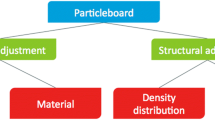Abstract
The interaction between particle size and resin content is one of the most important structural parameters that can influence the accuracy of predictions about wood-composite properties. We developed three kinds of equation (linear, quadratic, and exponential) for each mechanical property of particleboard based on slenderness ratio and resin content at a constant density (0.7g·cm−3). Results from SHAZAM software (version 9) suggested that the quadratic function was not significant, but the linear and exponential functions were significant. The interaction between particle size and resin content was analyzed by Maple 9 software. The results indicated that an exponential function can better describe the simultaneous effect of slenderness and resin content than a linear equation. Under constant resin content, particles with higher slenderness ratios increased more in modulus of rupture (MOR) and modulus of elasticity (MOE) than did particles with lower slenderness ratios. Edge withdrawal resistance (SWRe) values did not increase with increasing slenderness ratio.
Similar content being viewed by others
References
Azizi M, Ghorbannezhad P, Hatefnia H. 2009. Estimation of demand for wood panels in Iran by the year of 2012. Journal of Forestry Research, 20(2): 179–182.
Azizi M. 2008. A model of supplying poplar wood for Iranian paper & wood factories. Journal of Forestry Research, 19(4): 323–328.
Barnes D. 2001. A model of the effect of strand length and strand thickness on the strength properties of oriented wood composites. Forest Products Journal, 51(2): 36–46.
Cook DF, Chiu CC. 1997. Predicting the internal bond strength of particleboard utilizing a radial basis function neural network. Engineering Applications of Artificial Intelligence, 10(2): 171–177.
Dai C, Yu C, Jin J. 2008. Theoretical modeling of bonding characteristics and performance of wood composites. Part IV. Internal bond strength. Wood and Fiber Science, 40(2): 146–160.
Eckelman CA. 1975. Screw holding performance in hardwoods and particleboard. Forest Products Journal, 25(6): 30–35.
EN 310. 1993. Wood-based panels. Determination of modulus of elasticity in bending and of bending strength. The European Committee for Standardization.
EN 319. 1993. Particleboards and Fiberboards Determination of tensile strength perpendicular to the plane of the board. The European Committee for Standardization.
EN 320. 1999. Fiberboards determination of resistance to axial withdrawal of screws. The European committee for standardization.
Fernández GF, Esteban LG, Palacios DE, Navarro N, Conde M. 2008b. Prediction of standard particleboard mechanical properties utilizing an artificial neural network and subsequent comparison with a multivariate regression model. Invest. Investigación Agraria: Sistemas y Recursos Forestales, 17(2): 178–187.
Fujimoto Y, Mori M. 1983. Performance of wood screw joints for particleboard. Science Bulletin of the Faculty of Agriculture — Kyushu University, 38(1): 45–47.
Groves CK. 1998. A new method for measuring resin distribution in OSB. Technical Report, Forintek Canada Corp. p. 58.
Wang HB, Xu PW, Wang JM. 1994. The analysis of adhesive distribution on particle surface. Journal of Forestry Research, 7(4): 61–64.
Lin HC, Huang JC. 2004. Using single image multi-processing analysis techniques to estimate the internal bond strength of particleboard. Taiwan J For Sci, 19(2): 109–117.
Maloney TM. 1970. Rein distribution in layered particleboard. Forest Products Journal, 20(1): 43–52.
Maloney TM. 1977. Modern particleboard and dry process fiberboard manufacturing. San Francisco, CA: Miller Freeman Publications, p.672.
Miyamoto K, Suzuki S, Nakahara S. 2002. Effect of particle shape on linear expansion of particleboard. Journal of Wood Science, 48(3): 185–190.
Nemli G. 2003. Effects of some manufacturing factors on the properties of particleboard manufactured from Alder. Turkish Journal of Agriculture and Forestry, 27: 99–104.
Post PW. 1961. Relationship of flake size and resin content to mechanical and dimensional properties of flake board. Forest Products Journal, 11(9): 34–37.
Sackey E, Semple EK, OH SW, Smith GD. 2008. Improving core bond strength of particleboard through particle size redistribution. Wood and Fiber Science, 40(2): 214–224.
Scott KA. 2001. Economic feasibility of implementing a resin distribution measurement system for MDF fiber. Msc thesis. Virginia State University.
Semple EK, Smith DG. 2006. Prediction of internal bond strength in particleboard from withdrawal screw resistance models. Wood and fiber science, 38(2): 256–267.
Sun YG, Arima T. 1999. Structural mechanics of wood composite materials II: Ultrasonic propagation mechanism and internal bonding of particleboard. Journal of Wood Science, 45(3): 221–226.
Takuya N, Amin J, Ansell MP. 2004. Image analysis and bending properties of model OSB panels as a function of strand distribution, shape and size. Wood Science and Technology, 38(4): 297–309.
Wang K, Lam F. 1999. Quadratic RSM models of processing for a three-layer oriented flakeboard. J Wood & Fiber Sci. 31 (2): 173–186.
Lu YB, Wang JM, Hu GM. 1994. Analysis of computer vision on resin efficiency in particleboard. Journal of Forestry Research, 5(1): 76–81.
Author information
Authors and Affiliations
Corresponding author
Rights and permissions
About this article
Cite this article
Arabi, M., Faezipour, M., Layeghi, M. et al. Interaction analysis between slenderness ratio and resin content on mechanical properties of particleboard. Journal of Forestry Research 22, 461–464 (2011). https://doi.org/10.1007/s11676-011-0188-2
Received:
Accepted:
Published:
Issue Date:
DOI: https://doi.org/10.1007/s11676-011-0188-2




